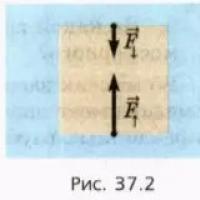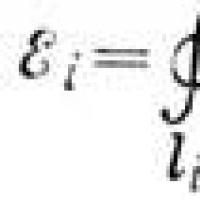What can be made from birch chips. Wood chips. Wood species for making chips
Wood chips for wood concrete are the main component of the material (from 75% to 90% of the total volume). Selection and preparation of wood filler is important stage, directly affecting the structural and thermal insulation characteristics of wood concrete.
Almost any wood is suitable for wood concrete. The best option would be to use coniferous species (for example, pine, spruce) or hardwood species (for example, birch, oak, poplar, aspen). It is strictly forbidden to use larch, beech (due to the increased content of substances harmful to cement - sugars), and also freshly cut wood cannot be used; it must lie down for 3-4 months.
To produce wood chips, any logging waste (twigs, branches, tree tops), woodworking waste (slabs, rounding residues), and secondary waste ( wooden furniture, pallets, etc.). The volume of wood filler should contain no more than 10% bark admixture, no more than 5% pine needles and leaves by weight of the dry filler.
Why is pine needles better? Wood contains substances that adversely affect the characteristics of wood concrete, especially its strength: various groups of sugars, starch, extractives. Their content in coniferous trees is less than in hardwood and other species. In any case, aggregate produced from the above rocks requires further preparation and processing. It’s just that removing sugars from the filler of hardwood trees, unlike coniferous trees, requires a little more effort and components.
Chemical composition of wood species
Wood chips: shape and size
The geometry and size of wood chips for preparing the wood concrete mixture is determined by GOST 19222 for wood concrete.

Wood chips
Firstly, according to GOST 19222, the wood fraction must have a needle-like shape to create a reinforcing effect and increase the strength of the material. Secondly, the best wood chips for wood concrete must meet the following requirements:
- length should not exceed 30 mm (optimal length 20 mm)
- The width should be no more than 10 mm ( best option 5 mm)
- thickness 5 mm
Machine for making wood concrete chips
The correct geometry and size of aggregate fractions can be obtained by manufacturing it on chipping and chipping machines. An excellent option for obtaining the correct needle shape and size of the chips is to use wood shredders. However, a wood shredder is a very expensive machine. Chip cutters for wood concrete (hammer crushers) will give no worse results. It is also possible to produce large size fractions on rotary chippers and then re-grind in a chip crusher.

Wood shredder
If you buy one of the machines described above, you can easily make wood chips with your own hands. But most often, wood filler is easier to purchase from forestry enterprises.
Preparing wood chips for wood concrete
Harmful substances contained in wood filler negatively affect the strength of wood concrete. Therefore, an important step before producing a wood concrete mixture is the preparation and processing of wood filler.
There are the following methods for preparing the aggregate:
Physical method
It involves treating wood with water, which washes out a significant portion of water-soluble substances. This is why freshly cut wood contains more water-soluble sugars than driftwood. Wood that is stored under cover will contain more water-soluble substances than wood that has been left out in the rain. A great effect can be achieved by soaking wood chips for a long time in a pool, but this requires space. It is enough to soak for a day in ordinary water or 2-3 hours in a warm place.
Chemical method
The easiest way: oxidation of tannins with atmospheric oxygen. To do this, the wood is kept in the air, and preferably under the sun.
Chemical reactions that occur during woodchip processing chemicals, convert sugars into insoluble and harmless compounds, and also create an impermeable film. To envelop wood waste with an impermeable film, urea-formaldehyde resin (KS-11 or KF-MT-P) is used. To reduce the influence of sugars harmful to cement, before creating a cement mixture, wood chips for wood concrete are impregnated with a mineralizer (4 - 10% bleach solution). The impregnation process is called mineralization.
In practice, it is popular to treat wood filler with solutions of calcium chloride, liquid glass and alumina sulfate to eliminate the effect of harmful sugars on cement. Calcium chloride should only be used on seasoned softwood wood chips. When using liquid glass and alumina sulfate, the type of wood and its exposure time are not important, however, when using them, the strength of the wood concrete decreases by almost half.

Calcium chloride or calcium chloride CaCl2
Biological method
Elimination of wood poisons is carried out using catalysts, which can be bacteria. This method includes simply heating the wood. It activates biological processes that will lead to partial fermentation and oxidation of water-soluble sugars. During the drying process, sugars become insoluble: they vitrify and crystallize.
Combined method
This method combines the above-described chemical and physical methods. However, it must be admitted that the combined method is labor-intensive.
There is an example of a combined method used in England. Boil the wood filler for 10 minutes and then rinse it in water. This partially removes water-soluble sugars. Then it is boiled in a 20% solution iron sulfate, for sedimentation of tannins.
Another recipe for a combined method: the wood chips are soaked in liquid glass for 5 hours to 24 hours, then they are washed and dried.
The section of GOST 19222 “Determining the suitability of wood filler” describes a method by which you can check the effectiveness of a particular method.
We got logs, beams, boards from the tree, the slab was used for the construction of scaffolding... But what about the whips, twigs, branches, bark? Where to put the soft mountains of shavings and compacted dunes of sawdust? After all, this is also wood, and the greater the yield of finished products from it, the more profitable it is. So there is such a thing as shredded wood. Moreover, partly it is a by-product, a semi-finished product for obtaining something, and partly it is produced as a special commercial product. Shredded wood includestechnological chips, crushed wood, wood shavings, sawdust, wood dust and wood flour.
wood chips and crushed grains and products from them
It is obtained both from wood waste and from solid wood. It is used as fuel, as mulch in the garden, and to improve the taste and aesthetic qualities of food and drinks (alder for smoking, oak for aging cognacs). Process wood chips are used as raw materials in the pulp and paper industry and for the production of hydrolytic alcohol.In construction, wood chips are used to produce wood concrete (concrete with wood - so it is warmer and you can even drive a nail into it). Wood chips are also widely used to obtain such building materials, like chipboard and fibreboard. The thickness of the chips for any use does not exceed 5 mm , length: greatest - upon receipt of chipboard (up to 60 mm ), the smallest is for the technological one (about 5 mm).
Using crushed wood is almost the same as using wood chipsThe difference is in the production: chips are obtained by splitting, crushed- on hammer mills and crushers.
Application of wood chips
 It is usually obtained by planing, most often from soft or coniferous species.According to the production technology, two types can be distinguished: specially prepared chips and waste chips. Its dimensions depend on its purpose. For example, to pack eggs you need large chips, to pack apples you need thin and narrow ones. In general, chip sizes vary within the following limits: thickness - 0.05- 0.5 mm, width - 2-8 mm, length - 200-530 mm.
It is usually obtained by planing, most often from soft or coniferous species.According to the production technology, two types can be distinguished: specially prepared chips and waste chips. Its dimensions depend on its purpose. For example, to pack eggs you need large chips, to pack apples you need thin and narrow ones. In general, chip sizes vary within the following limits: thickness - 0.05- 0.5 mm, width - 2-8 mm, length - 200-530 mm.
It is also used in agriculture for bedding, and furniture industry for the manufacture of chipboards, and as containers and fuel. But we are more interested in construction applications: acoustic and heat-insulating cement-bonded particle boards are made from it, which are lightweight concrete, that is, wood concrete.
Sawdust and its use
 Sawdust can generally be called a waste, but very valuable, raw material. And where are they not used? Cellulose, cardboard, paper, hydrolytic alcohol are also sawdust.Clean the fur, please. Bedding the livestock is no problem. You can insulate strawberries for the winter, and in rainy summers you can easily save them from sand with the help of sawdust. Getting compost or mulching the soil with sawdust is not difficult. Sawdust does a good job of filtering wastewater: it’s twice as good as activated carbon.
Sawdust can generally be called a waste, but very valuable, raw material. And where are they not used? Cellulose, cardboard, paper, hydrolytic alcohol are also sawdust.Clean the fur, please. Bedding the livestock is no problem. You can insulate strawberries for the winter, and in rainy summers you can easily save them from sand with the help of sawdust. Getting compost or mulching the soil with sawdust is not difficult. Sawdust does a good job of filtering wastewater: it’s twice as good as activated carbon.
They are also indispensable in construction. Plates made from sawdust with shavings using the extrusive method (punching) have increased wear resistance and hardness. If xylolite waste is added to the sawdust before pressing, the slabs become fireproof and frost-resistant.
Sawdust is a good heat insulator, not necessarily in the form of a filler in mixtures and solutions, but also in a loose state. For example, mansions are now insulated this way: the internal masonry is made of porous concrete, the external one is made of brick, between them there is an air layer, usually covered with dry sawdust.
Wood dust and flour
Wood dust consists of wood particles measuring 15-20 microns. It is formed during wood processing. Although it forms during any wood processing, it is most often a by-product of sanding furniture. And although it can be used, for example, as a filler in composite materials, this does not happen often. They simply don’t want to mess with it: there is no industrial volume of its production, and in itself it is explosive.
 Wood flour is produced specifically by grinding dry wood. Basically, the raw material for its production is dry shavings. Its dimensions and particle size distribution are regulated by GOST. Wood flour has found application in petrochemistry, in the production of fine ceramic filters, and in the manufacture of composites. At construction sites, its use is important for the production of grinding, polishing and dry mixtures, as well as linoleum.
Wood flour is produced specifically by grinding dry wood. Basically, the raw material for its production is dry shavings. Its dimensions and particle size distribution are regulated by GOST. Wood flour has found application in petrochemistry, in the production of fine ceramic filters, and in the manufacture of composites. At construction sites, its use is important for the production of grinding, polishing and dry mixtures, as well as linoleum.
Sometimes money lies right under our feet, we just need to see it in time and properly master it. This is what savvy entrepreneurs do. As an example, let's take working with wood and waste from its processing - sawdust. In this article we will tell you what can be made from wood and sawdust
What can be made from wood - business ideas
Wood of various species is widespread in all regions of Russia, with the exception of certain arid places or areas with unfavorable climatic conditions. But even where the tree is not mined, it can be processed.
That is why the business related to wood is quite developed in Russia. Below we will consider the most relevant areas of production activity for small businesses and micro-enterprises.
It’s worth mentioning right away that wood means not only solid wood, but also panel materials (plywood, OSB, chipboard, etc.).
Production of furniture from chipboard
This is probably the most popular implementation of business ideas made of wood. If you want to sell in large retail chains, furniture stores, etc., you will have to significantly invest in equipment, but with trained personnel there should be no problems (the complexity of the work is low).
Minimum necessary equipment(taking into account the available space for processing and storing materials/finished products):
- Sawing machine - from RUB 500,000 (used, without sheet feeding, two people required for maintenance).
- Edge maker (edge banding machine) - about 200,000 rubles. (these are manual models without automatic part feeding, only for straight edges).
- Dust removal system (sawdust extractor) - about 70,000 rubles.
At first, with small volumes of orders and simple details The additive can be done manually with a drill; sharpening of saw blades can be done for a fee in the appropriate workshops.
Chips are particles made by grinding wood raw materials. The production of this material is carried out by both large specialized enterprises and small private workshops. The cost of wood chips is low, which determines the feasibility of its use primarily as alternative type fuel. Wood chips can also be used in other areas of the national economy.
Scope of use
Wood chips are used mainly in domestic (and sometimes industrial) boiler houses. The use of this type is considered the most economically justified in populated areas remote forest areas of the Urals, Siberia and the European part of Russia. Especially where there is widespread production. Boilers for wood chips are structurally practically no different from equipment that uses coal. Therefore, switching to heating with this type of fuel does not cause any special costs. All that needs to be done in this case is to install a special supply line.
Wood chips can also be used in the production of furniture, as decorative element when arranging parks and gardens, when smoking products, making wood concrete blocks, etc. However, its main purpose is still the heating of domestic and industrial premises.
General description
Wood chips, the most appropriate use of which as fuel, have both their advantages and disadvantages. The advantages of this material include primarily:
low production costs;
a sufficient amount of raw materials used in production;
relatively low ash content;
possibility of year-round production.
The disadvantages of wood chips as a fuel material are:
not too high energy value;
low material density;
high humidity, and therefore the need for drying;
instability to rotting;
difficulties during storage due to the tendency to spontaneous combustion.

Production equipment
Wood chips are produced either on special machines, or using modern combines. The first type of equipment is usually used by small production workshops. Harvesters produce wood chips directly at logging sites and in much larger quantities. Such equipment is purchased by large specialized companies.
Threshing or chipping machines can be used to produce chips. The latter are used more often. Threshing equipment is more suitable for the production of fuel pellets and fine wood fractions for briquettes.
Chippers can be used to produce both fuel and process chips (intended for the production of chipboard or composite) chips. In turn, the latter are divided into screw, disk and drum. The first two varieties are usually used for processing whole trunks and long material. Drum machines are more suitable for producing chips from heterogeneous wood (logging waste). Chippers can operate from their own engine or from the power take-off mechanism of a truck or tractor.

In addition to the actual chipping machines, today entire complexes are produced, supplemented by feed lines, receiving hoppers, and sometimes drying machines. Production wood chips Decorative also involves the use of special equipment designed for painting.
Harvesters
This modern technology can perform the following operations:
felling thin-trunked (and sometimes regular) timber;
feeding it into the chopping hole;
quick chopping into chips;
feeding the latter into the receiving container via a scraper conveyor.
Types of material
Types like this alternative fuel, like wood chips, there are several. The most popular is the so-called stem chips. Its advantages include, first of all, a low bark content, high energy value, and low ash content.
Less valuable is wood chips produced from waste from wood processing and timber processing, as well as from logging residues.

Price
The price of this material depends both on its purpose and variety, and on what kind of wood was used in its manufacture. The cost of fuel chips may depend on the ash content, percentage of bark content, particle size, etc. The price for this type of material usually ranges from 300-700 rubles. per cubic meter. Decorative wood chips are much more expensive. The price for this material is 200-400 rubles per bag. The cost is even higher for wood chips intended for smoking sausages, lard, etc. Apple, pear, alder, cherry, etc. material can be purchased for 100-400 rubles per kilogram.
It is no secret that, starting from the timber harvesting stage, a huge amount of waste is generated at all stages of wood processing. These are tree branches, tops, twigs, stumps, slabs, substandard wood, sawdust and trimmings.
There are different ways reduce the volume of wood waste. The easiest way is to burn them, but this is ineffective and does not bring sufficient profit. Another way is to process wood waste into wood chips.
To produce wood chips, various wood chipping machines are used, which allow you to quickly crush large volumes of wood waste and obtain high-quality industrial wood chips at the output. Wood chip production is a profitable business that can generate constant income, taking into account the uninterrupted supply of raw materials.
Detailed information from the equipment manufacturer on the PRM chipping machines page
Chips are crushed wood of established sizes, obtained as a result of grinding wood raw materials with chippers and special devices, used as technological raw materials or fuel.
Use of wood chips
What is made from wood chips? Wood chips have a wide range of uses. Wood chips are often used as fuel to operate gas generators. Wood chip boilers make it possible to provide homes and businesses with steam and heat. Gas generators that can operate on wood waste are more economical. If for the production of wood chips you use not just a wood chipper, but an entire production line, which will include a chip cutter, a drum dryer, a gas generator, a sorting and packaging plant, conveyors and bunkers for feeding the material, then at the output you can get chips for smoking with low humidity , which will increase the shelf life and quality of the product. Alder chips are highly valued by smoked meat producers. Large factories producing smoked sausages, smoked fish, and smoked cheeses will be happy to cooperate with you. If you add a painting installation, you can produce colored decorative chips, which are used by specialists for landscape design and decorating lawns. Selling wood chips will allow you to receive a guaranteed profit, since this product is currently in demand by consumers.

Wood Chip Sizing
If it is necessary to produce wood chips of a certain fraction, or to calibrate the material, then drum chip crushers equipped with removable meshes with a given mesh size are used for these purposes. This allows the production of wood chips of any type given size. For example, if you specialize in making wood chips for smoking, then know that using wood chips of the same size in smokers can achieve a more consistent result. This will avoid the effect that while large chips produce smoke for smoking, small ones burn, form a flame and can spoil the product. Technological chips of the same size are also suitable for the production of building materials (wood chips for wood concrete), the homogeneity of the mass ensures high quality of the final product. Wood chip machines with sizing meshes significantly increase production capabilities.

Technological chips - chips for the production of cellulose, wood boards and products of wood chemical and hydrolysis industries. It is made from thin round wood raw materials with a diameter of 2-6 cm and a length of 1.0-3.0 m with a gradation of 0.5 m and maximum deviations along the length of ±5 cm.
Production of wood concrete from wood chips

If you purchase equipment for wood concrete, you can open a business producing modern high-tech wood concrete wall blocks. Wood concrete blocks are made from wood chips and cement binder; construction wood concrete is safe for human health, it is lightweight, retains heat well, does not freeze, does not rot, and does not burn. Wood concrete panels are used for suburban low-rise construction residential buildings and cottages, courtyard buildings, bathhouses, garages, storage facilities, cowsheds and poultry houses, industrial buildings. Projects for arbolite houses are practically no different from buildings made of brick or other types of wall blocks. Building houses from wood concrete is an excellent alternative to log houses.
Manufacturers of equipment for wood concrete offer a set of machines, which includes a chip cutter for wood concrete, a mixing station, molds for wood concrete blocks of different sizes, manual rammers or tampers with a weight, a vibrating table, drying chamber. High quality wood chips for wood concrete guarantees a stable result, correct proportions of wood concrete, each batch of material will be the same without deviation from the standard, which is important for construction work. High-quality wood concrete blocks are in demand on the market, this will make it easy to organize sales.
Wood chips for the production of building materials

Wood chips are also used for the production of chipboard, fiberboard, cardboard and paper, plywood, briquettes for heating, wood pellets and pellets, and plasterboard. In this case, wood chips are further crushed in wood chippers to obtain a finer fraction. Using wood chips to produce the building materials we use in everyday life allows you to significantly reduce wood consumption and reduce the volume of wood waste. If you invest in equipment, then wood chips will no longer be a waste of wood production, but will become a valuable secondary product on which you can make money and put it into business. Substandard wood and industrial chips will no longer lie as dead weight on the territory of forest industry enterprises; it is very easy to give them a second life for the benefit of society.
 What documents are evidence that the apartment is a service apartment?
What documents are evidence that the apartment is a service apartment? Space donut hole
Space donut hole Types of discounts on Russian Railways tickets and rules for obtaining them Train tickets for students
Types of discounts on Russian Railways tickets and rules for obtaining them Train tickets for students Lecture on syndromic pathology
Lecture on syndromic pathology Organizational aspects of the activities of pharmacy organizations
Organizational aspects of the activities of pharmacy organizations Water Pressure in the Deep Ocean Practice Reports
Water Pressure in the Deep Ocean Practice Reports What is inductance, its definition and unit of measurement
What is inductance, its definition and unit of measurement